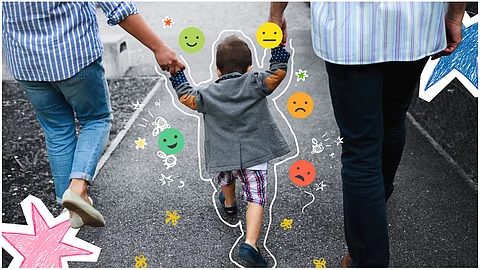
- NEWS
- the EDIT
- COMMENTARY
- BUSINESS
- LIFE
- SHOW
- ACTION
- GLOBAL GOALS
- SNAPS
- DYARYO TIRADA
- MORE

It’s long been understood that how children learn to regulate their emotions, whether it’s calming themselves down during a tantrum or coping with disappointment, starts at home. But new research is showing that both fathers and mothers play vital, and at times different, roles in shaping this emotional development.
According to a review published in the National Library of Medicine, Kiel and Kalomiris (2022) looked at recent findings around how emotion regulation (ER) develops within the parent-child relationship. Their conclusion: parenting is not a one-way street, and it’s not just about mothers anymore. Children’s emotional development is influenced by both parents, in unique and evolving ways.
In infancy, babies turn to both their mother and father for help in managing feelings of distress. When either parent becomes unresponsive, babies rely on self-soothing or distraction strategies. Surprisingly, however, the study found that infants reacted more strongly to a silent mother than to a silent father. The researchers suggest that this might be because infants tend to spend more time with their mothers during the first year and come to rely on them more consistently for emotional cues.
But as children grow, fathers’ roles become more distinct — and sometimes even more influential in certain domains. For example, while both parents help young children manage frustration, fathers are more likely to encourage emotional independence, especially when it comes to stereotypically "male" emotions like anger.
Interestingly, the study notes that when fathers show less support for emotional expression, especially when boys express sadness or girls express anger, it can increase the child’s risk of developing behavioral or mental health issues later on. On the flip side, when fathers are supportive, especially in cases that align with social gender norms (e.g., showing support for sadness in daughters or anger in sons), this support becomes particularly meaningful to children.
Mothers tend to have a more direct impact on children's day-to-day emotion coaching. They're often the ones children turn to for comfort or explanation during emotional situations. Mothers are also more likely to openly discuss emotions, especially with their daughters, a behavior the researchers suggest may stem from how they themselves were raised.
During middle childhood and adolescence, maternal emotional responses are more closely linked to how well children regulate their feelings. That said, the influence of both parents is shaped by their relationship with each other. The research found that fatherly influence is more positive and effective when the mother-father relationship is low in conflict.
One of the more eye-opening findings in the study is that children don’t just passively absorb emotional lessons from their parents — they shape those lessons through their own behavior. For example, when toddlers use more adaptive regulation strategies, like seeking comfort or expressing their emotions calmly, parents often respond with more supportive behaviors.
On the flip side, children who show frequent or inappropriate displays of fear or anger — like being afraid in low-threat situations — can unintentionally encourage overprotective parenting. This creates a cycle where children learn to depend on their parents too much, which can hinder the development of their own coping skills.
The study also highlighted how culture affects how emotion regulation is taught and interpreted. For example, children in the U.S. are more likely to be taught to hide sadness, compared to children in Ghana or Kenya. In families from Asian or African American backgrounds, emotional restraint or control may be valued more than open expression, leading to differences in how children learn to cope.
Interestingly, the same parenting behavior can have different impacts depending on cultural context. What works for one family may not work for another. That’s why the researchers stress that interventions and parenting advice should be culturally sensitive—and take into account socioeconomic and regional factors as well.
The takeaway from this review is clear: both mothers and fathers matter, and the ways they interact with their children emotionally can have lasting impacts. Fathers bring their own style of guidance, often helping shape gendered responses and promoting independence. Mothers tend to offer emotional coaching and maintain stronger day-to-day influence — particularly during early and middle childhood.
But children aren’t blank slates. They bring their own emotional tendencies to the table, which in turn shape how their parents react. And all of this unfolds within a larger cultural backdrop that influences what kinds of emotional expression are considered acceptable — or even encouraged.
For parents, the message is empowering. Emotion regulation isn’t set in stone at birth. It’s a dynamic, ongoing interaction between child and parent, shaped by love, attention, and yes — even a bit of frustration now and then.
